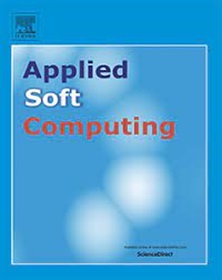Intelligent compressive strength prediction of sustainable rubberised concrete using an optimised interpretable deep CNN-LSTM model with attention mechanism
IF 6.6
1区 计算机科学
Q1 COMPUTER SCIENCE, ARTIFICIAL INTELLIGENCE
引用次数: 0
Abstract
The increasing environmental concerns associated with waste rubber disposal, particularly from used tyres, have led to the exploration of rubberised concrete as a sustainable construction material. Rubberised concrete provides benefits like enhanced flexibility and energy absorption; however, its reduced compressive strength remains a challenge for structural applications. This study puts forward an advanced deep learning model to accurately evaluate compressive strength of rubberised concrete by combining a hybrid convolutional neural network (CNN) and long short-term memory (LSTM) network enhanced with attention mechanism, and optimised using the enhanced firefly algorithm (EFA), featuring chaotic initialisation and nonlinear learning factor for improved convergence, for hyperparameter tuning. The proposed model introduces computing novelties: attention-guided CNN-LSTM feature fusion and chaos-enhanced firefly optimisation. Then, it is trained on an extensive dataset incorporating key mix parameters, including water, cement, supplementary cementitious materials, superplasticiser, coarse and fine aggregates, crumb and chipped rubber content, and concrete age, with validation supported by experimental tests in the laboratory. The proposed model achieves superior prediction accuracy, achieving R² values of 0.967 for training and 0.943 for testing, outperforming conventional machine learning methods. Evaluation metrics showcase the superior performance of model, with root mean square error of 2.966 MPa and 3.757 MPa for training and test data, respectively. A sensitivity analysis based on SHapley Additive exPlanations (SHAP) highlights coarse aggregate, rubber content, and concrete age as the most influential variables affecting compressive strength. By providing a highly accurate, interpretable, and cost-effective predictive tool, this research facilitates the optimisation of rubberised concrete mix design, supporting its broader adoption in sustainable construction practice.
基于优化可解释深度CNN-LSTM模型的可持续橡胶混凝土抗压强度智能预测
与废弃橡胶处理有关的环境问题日益增加,特别是来自旧轮胎的橡胶处理,导致了橡胶混凝土作为可持续建筑材料的探索。橡胶混凝土具有增强灵活性和能量吸收等优点;然而,其降低的抗压强度仍然是结构应用的挑战。本研究结合混合卷积神经网络(CNN)和增强了注意机制的长短期记忆(LSTM)网络,提出了一种先进的深度学习模型来准确评估橡胶混凝土的抗压强度,并使用增强型萤火虫算法(EFA)进行优化,该算法具有混沌初始化和非线性学习因子以提高收敛性,用于超参数调谐。该模型引入了新的计算方法:注意引导的CNN-LSTM特征融合和混沌增强的萤火虫优化。然后,它在包含关键混合参数的广泛数据集上进行训练,包括水、水泥、补充胶凝材料、超塑剂、粗骨料和细骨料、碎橡胶含量和混凝土龄期,并在实验室的实验测试中得到验证。该模型具有较好的预测精度,训练R²值为0.967,测试R²值为0.943,优于传统的机器学习方法。评价指标显示了模型的优异性能,训练数据和测试数据的均方根误差分别为2.966 MPa和3.757 MPa。基于SHapley添加剂解释(SHAP)的敏感性分析强调,粗骨料、橡胶含量和混凝土龄期是影响抗压强度的最重要变量。通过提供一个高度准确、可解释且具有成本效益的预测工具,本研究促进了橡胶混凝土混合设计的优化,支持其在可持续建筑实践中的广泛采用。
本文章由计算机程序翻译,如有差异,请以英文原文为准。
求助全文
约1分钟内获得全文
求助全文
来源期刊

Applied Soft Computing
工程技术-计算机:跨学科应用
CiteScore
15.80
自引率
6.90%
发文量
874
审稿时长
10.9 months
期刊介绍:
Applied Soft Computing is an international journal promoting an integrated view of soft computing to solve real life problems.The focus is to publish the highest quality research in application and convergence of the areas of Fuzzy Logic, Neural Networks, Evolutionary Computing, Rough Sets and other similar techniques to address real world complexities.
Applied Soft Computing is a rolling publication: articles are published as soon as the editor-in-chief has accepted them. Therefore, the web site will continuously be updated with new articles and the publication time will be short.
 求助内容:
求助内容: 应助结果提醒方式:
应助结果提醒方式:


